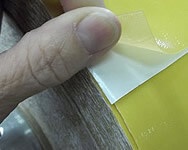Adhesive Roll Coaters and How They Work

These are confusing questions–at first. But as you take in the information below, you’ll find that these machines aren’t so complicated. Take a look!
Types of Roll Coaters
You’ll find five main types of roll coaters–with different pros and cons attached to each one. They include:
Die coaters. In this process, adhesive roll coaters actually pump the adhesive material through a die, ultimately transferring it onto a web. The entire time, it’s supported by a backup roller, ensuring stability and consistency. The speed of the pump corresponds with the weight of the coating. Typically, we use die coaters when producing labels.
Gravure coaters. What distinguishes gravure coaters is the engraved gravure roll. That engraved pattern determines the amount of the coating it delivers. Additionally, gravure coaters use a specific applicator, usually a pressurized pan or head, to apply the coating.
Flex bar coaters. You’ll find flex bar coating to be a unique process. Here, the coater dips into a pan, picking up adhesive coating. It meters the coating between a flex bar and an applicator. Usually, flex bars utilize a form of tape.
Reverse roll coaters. Here, the coaters work with an applicator roll, as well as rubber-coated backup rolls, and metering rolls. They feed both the substrate and the adhesive in opposite directions.
Rod coaters. Here’s one way you can connect rod coating and flex bar coating processes: both often use packing tape. However, the road coater’s parts differ. Obviously, the coater has a rod; as well as an applicator roll and a three-part, multi-chambered pan, and a pump. At a constant rate, the coating flows into the center of the multi-chambered pan, constantly. Naturally, you’ll have overflow, spilling into the other two pans. As the overflow picks up, it washes out various types of debris that tends to fall into the center adhesive coating. The applicator then picks up the adhesive before transferring it to the web, with thickness determined by the rod.
What do we use adhesive roll coaters for?
In manufacturing, we often need to apply hot melt and cold glue adhesives to different types of substrates. Without a hot melt roll coater, we simply can’t do that effectively. Typically, we use a hot melt roller to apply coating to surfaces like wood, paper, metal, and plastic. The coatings themselves ensure that these materials are more durable. They’re more resistant to heat and cold, as well as erosion and corrosive properties. Of course, this all depends on the type of coating, as well as the technique we use to apply it.
Speaking of techniques–depending on the process you select, one of the benefits of using adhesive roll coaters is that you’ll often save both time and money. Of course, this means you must tune the roll coaters carefully, ensuring they’re perfectly customized to your specific project. And before you begin coating, it’s a good idea for you to know a bit more about the specifics–especially the difference between coatings and laminates.
What is the difference between coating and laminate?
On the surface, laminates and coatings may seem to have a lot in common. In fact, many mistake laminates for coatings due to their visual similarities. However, the lamination process often involves a thin layer made separately during the production. We then attach this layer to the surface later. Usually, laminates offer thinner layers in general, which can allow for more breathability. Depending on the product you’re working on, this may ultimately be a good thing. However, in some cases laminates don’t offer the durability we need. Despite this, laminates typically come with a high price tag. This is because laminates can be more durable than coatings. That is in part because laminates act as this totally protective layer. It’s thicker and less curved around the surface.
With coating on the other hand, we apply the material directly to the substrate. We can apply coatings to different parts of the surface, which you’ll find super helpful in some cases. Depending on the substrate we’re working with, as well as its purpose, coatings can be breathable or non-breathable, giving you more flexibility than you might have with the more rigid qualities of laminates. In general, coatings tend to be more flexible than laminates. While this can affect durability, it also gives you more options.
What do we consider when selecting roll coaters?
Keep these factors in mind when choosing between adhesive roll coaters. Consider:
The type of adhesive. Different curable adhesives require different roll coater properties. With hot melt adhesive, you’ll need a roll coater that heats the adhesive before working with it.
Substrate thickness. Examine the substrate before picking a roll coater. Flexible substrates like paper or thin films, use a pressure roller or a dual feed system. Additionally, know what makes up the roll coater machine–the wrong materials can degrade the adhesive coating or ruin the equipment if matched with an incompatible coating.
Full coat or partial coat. Some machines only coat the edge of a material, while others only coat patterns. Know how much of the substrate you must coat when selecting a roll coater.
The width of the substrate. The machine must be at least two inches wider than your chosen surface.
Top or bottom coating. Depending on the side of the substrate you’re working with, you may select one coating machine or the other.
Cleanup. You’ll want a machine that you can easily disassemble–it saves both time and effort.
Obviously, there is a lot to consider as you choose between adhesive roll coaters. Luckily, CTI is here to help. In fact, we can actually do most of the coating for you. Call us at 419-924-5566 or contact us here for more info!
- << < Previous Post
- 1
- 2
- ...
- 9
- ...
- 241
- 242 Next Post > >>

